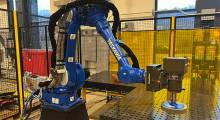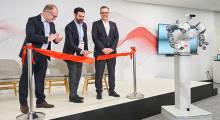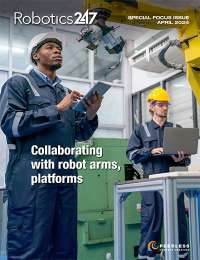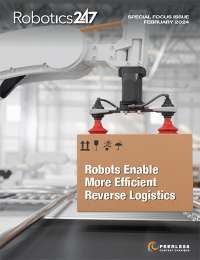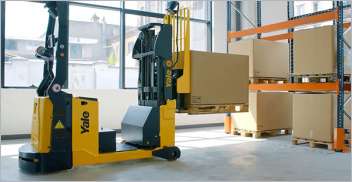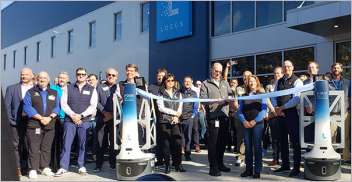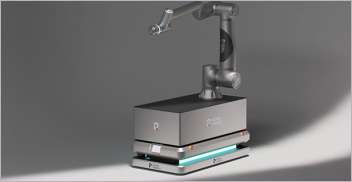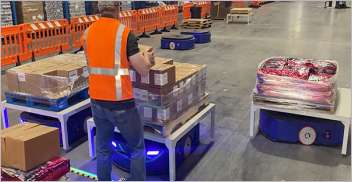Many small and midsize manufacturers have been unable to take advantage of automation because of the cost and technical support required to deploy and maintain the systems. Developers are ramping up efforts to introduce ease-of-use features to make robots more accessible to a broader, more transversal pool of users.
Making robots easier to implement and use has helped smaller shops find a home for them on their shop floors.
“Ease of use is not just a ‘nice to have’ feature,” said Joe Campbell, senior manager of applications development and strategic marketing at collaborative robot leader Universal Robots. “It’s key to breaking down the traditional cost and complexity barriers to automation adoption.”
Robot designs imitate consumer devices
An examination of the ease-of-use features on the market today reveals that many mimic everyday consumer technology. Robotics companies are applying this approach to both hardware and software.
To see how designers are using familiar technology to break down the barriers to robot adoption, consider how the latest generation of teach pendants democratizes the programming process.
“Tablet-like teach pendants are now similar to iPads and other consumer tablets,” said Josh Leath, a senior product manager at Yaskawa Motoman.
The software residing on these devices also mimics consumer offerings, using graphical user interfaces to replace more cumbersome traditional software approaches. Take, for example, ABB’s Wizard Easy Programming interface.
“This intuitive graphical user interface allows users new to robot programming to initiate programming actions using a graphical drag-and-drop style block,” explained Joshua Alphonse, local business-line manager for electronics U.S. at ABB's Robotics and Discrete Automation Division. “The blocks are laid out in chronological order, with each step identified in easy-to-understand everyday language.”
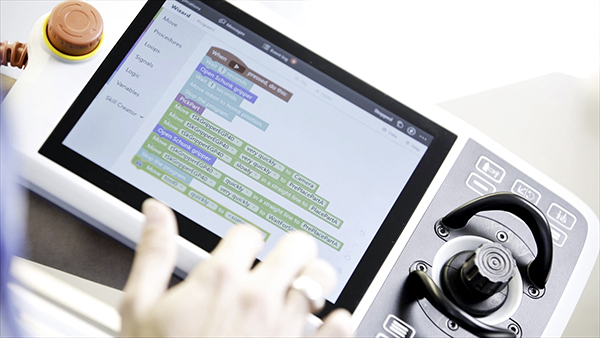
Yaskawa Motoman has simplified robot programming by incorporating offline programming and operating systems that resemble common programming languages and techniques like Python or AutoCad.
The application of ease-of-use design practices doesn’t stop here. Leading robot developers like ABB and Universal Robots are using sensor- and AI-enabled hand-guided programming techniques in which the robot literally mimics the human operator.
“At ABB, we have developed lead-through programming, mainly for our collaborative robot line,” said Alphonse. “They allow customers to simply move the robot arm manually to the desired location for a pick or place position and record that position with a click of a button. By defining a few basic locations for the robot to know where to operate, our software calculates the optimum path for the robot to move to complete the task.”
All of these features eliminate the need for deep programming skills and can make robotics more approachable to a wider audience rather than specialized robotics engineers.
Developers turn to open technology
Some robotics designers are also using open software such as the Robot Operating System (ROS). The intent is to make it easier to incorporate these systems into plantwide automation infrastructures.
“By developing increasingly open robotic solutions fully compatible with popular software management systems, PLCs [programmable logic controllers], and related devices, companies such as Comau are opening the door to easy automation,” said Mark Anderson, head of robotics and automation products North America at Comau.
“As a result, small to midsize manufacturers can now integrate robots quickly, easily, and economically, both within existing work lines and in new [Industry] 4.0-enabled production systems.”
Ease of use becomes a catalyst for change
The simplification of robot programming and operations through the introduction of the easy-to-use features is providing the catalyst for many small and midsize manufacturers to make the leap to incorporating robots into their operations.
One example can be seen in a recent deployment by DeAngelo Marine Exhaust, a midsized manufacturer of custom exhaust systems.
“We are very much a custom shop, where no two exhaust systems are exactly alike,” said Justin Montes, CEO of DeAngelo. “Each of these different systems has like parts on them.”
“Prior to the cobot, we would throw all the parts on a cart, and our fabricators would have to weld them together,” he said. “Everything we do at DeAngelo is TIG welded by hand at a speed of about 2 to 5 in. per minute.”
When the company explored the possibility of deploying a robotic welder, it considered several automated and traditional welding companies and ultimately decided on a unit from Hirebotics. The key factor in the decision was ease of use.
“When we started looking into the technology, we saw just how easy these robots were to operate,” recalled Montes. “That was the real game changer for me. From my perspective, it would be a waste of time and money acquiring a robot, only to have it sit unused because it was too hard to operate.”
To achieve ease of use, a number of design techniques come into play.
“Hirebotics’ cobot runs off an app that you can download on any device,” explained Montes. “There’s no intimidating computer programs or manuals to get lost in. As for support, if you have any questions, the app has a substantial library of exercises and troubleshooting techniques.”
As a result, programming expertise and extensive experience with robotics were not required.
“It used to be that the only companies that could utilize robotics were multibillion-dollar companies that had entire departments of employees, with years of robotics training,” said Montes. “With the improvements in robotic technology in recent years, however, that just isn’t the case anymore. The ease of use is truly remarkable.”
“Within 20 minutes of uncrating our cobot, we were running parts, and with the increased speed of the cobot, we instantly raised our manufacturing capacity, lowered our lead times, and lowered our defect rate,” he added. “From a financial perspective, now that the welding is performed by a machine operator rather than a fabricator, our cost per part has plummeted. This puts us in a very advantageous position when it comes to acquiring more business.”
Flexibility increases ease of use
“Flexibility” can sometimes be a synonym for ease of use, and the ability to inject greater flexibility into manufacturing is highly valued by small and midsize manufacturers seeking to increase efficiency and quality.
This was precisely what Ajax Metal Forming Solutions—a maker of tight-tolerance metal parts—aimed to do when it turned to Yaskawa Motoman and systems integrator Mechatronic Solutions for a turnkey robotic workcell.
Ajax decided on the dual-workstation ArcWorld LC (Lite Cell) workcell, with a single high-speed AR1440 arc welding robot coupled with a Miller Auto-Continuum 350 power source.
Suitable for welding small to midsize parts in low-mix settings, the configuration features a fixed tooling table in each workstation divided by a partition. This layout enabled Ajax operators to safely prepare one side of the workcell while the robot operates in the other, optimizing efficiency.
“With this workcell, both tooling and end effectors can be changed quickly and easily, which is a huge time-saver,” said Antoniy Petkov, process improvement engineer at Ajax Metal Forming Solutions. “The two workstations can be individually tooled to weld different parts or used for sequential operations. That flexibility helps us accommodate more customers and projects.”
About the Author
Follow Robotics 24/7 on Linkedin
Article topics
Email Sign Up






